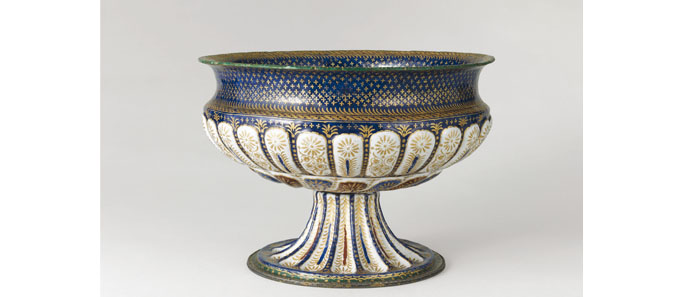
Italian Renaissance enamels on copper. Artistic geography, collecting and technology / Les cuivres émaillés de la Renaissance italienne. Géographie artistique, collectionnisme, technologie

In collaboration with the Musée du Louvre and the Centre de Recherche et de Restauration des Musées de France (C2RMF), Paris, the Institute of Art History has organised an international conference on the production of Renaissance enamels on coppers (so-called veneziani). The conference will be attended by art historians, conservators and restorers together with experts in the field of diagnostics and physical-chemical analysis. In Italian Renaissance decorative arts, enamels on copper were a relatively small but highly refined production, traditionally attributed to Venetian manufacturers. Most of the preserved pieces consist of ceremonial table services made up of goblets (at times with lids), plates, bowls, saltcellars, jugs and flasks. Other items include small caskets, torch holders, cande- labras and mirrors, while some paci, burettes, reliquaries and ostensories also attest to religious uses. In this art the metal giving the object its form also acts as a support for a richly coloured and gilded decoration, made up of several layers of enamel alternated with white, blue, purple or green grounds, embellished with touches of red. Admired and collected in the 19th century (when the principal European collections were being formed), enamels on copper dating back to as early as the late 15th cen- tury then went out of fashion. The interdisciplinary conference sets out to further knowledge about these works of very high artistic standards – they can be seen in major museums and collections worldwide – from the point of view of the manufacturing techniques, form and decoration and in terms of the social-cultural context in which they were produced. The themes will include defining a corpus of their forms and decorations; describing patrons and customers, especially through the study of heraldry and emblems; and lastly reconstructing their arrival on the Euro- pean art markets in the 19th century and the America markets in the 20th century. The Venetian origin of this production will be discussed and reconsidered with the contribution of recent archive research, the study of glassmakers’ recipe books and the results of physical-chemical inquires con- ducted by C2RMF, Paris, LAMA, Venice and the Opificio delle Pietre Dure, Florence. During the three days of the conference the enamelled copper mirror from the collection in the Palazzo Cini Gallery will be on show to the public. Restored for the occasion by the Opificio delle Pietre Dure, it is the second most important mirror of its kind after the one in the Louvre.
